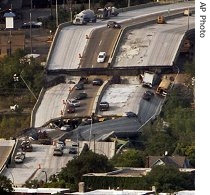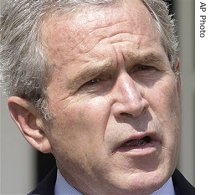2007年VOA标准英语-Recovery Effort Continues at Collapsed Minneapo(在线收听)
Houston
02 August 2007
Officials in Minneapolis are preparing for more sad news as recovery efforts go forward on the Mississippi River, where a major bridge collapsed Wednesday. There are only four confirmed deaths from the incident, but about 50 vehicles fell into the water when the bridge collapsed and authorities expect to find more bodies in the coming hours. VOA's Greg Flakus has more on the story from Houston.
A day after the collapse of the 35 West freeway bridge near downtown Minneapolis, recovery crews worked carefully around the rubble, much of which is submerged in water, trying to locate bodies. Authorities say they do not expect to find any more survivors.

An aerial view of the collapsed Interstate 35W bridge over the Mississippi River in Minneapolis, 02 Aug 2007
They say the death toll is likely to rise as crews remove rubble and bring up submerged vehicles.
Police officials say, in the first hours after the collapse, rescue workers located several people who were pinned under rubble, but were unable to save them.
 |
| President Bush comments about the collapsed bridge in Minneapolis, 02 Aug 2007 |
"I told them we would help with rescue efforts, but also told them how much we are in prayer for those who suffer," he said. "And I thank my fellow citizens for holding up those who are suffering right now in prayer."
In Minneapolis, U.S. Secretary of Transportation Mary Peters announced an immediate grant of $5 million to help reroute traffic in the busy metropolitan area around the bridge.
Investigators from the National Transportation Safety Board are also on hand to begin an investigation into why the structure failed. Authorities say there is no indication of sabotage or terrorist involvement in the incident.
Recent inspections of the fallen bridge revealed structural fatigue, but nothing that would have required it to be closed. Authorities say there are tens of thousands of bridges in the United States with signs of structural fatigue and that there is no reason to believe they are not safe.
In Minneapolis, the focus for the moment is on locating up to 30 people reported as missing and recovering vehicles and bodies from the river.
Police Chief Tim Dolan says recovery crews face danger entering the debris-filled area under the bridge where undercurrents can be treacherous. He says the next phase of the recovery effort will be slow and cautious.
"We know that there are numerous other vehicles that are in the water and so the recovery involving those vehicles and people who may be in those vehicles is going to take a long time," said Dolan. "We are planning on staffing this perimeter for three days minimally and it is probably going to be longer as far as the recovery aspect of this incident. So we do want to again reiterate that our sympathies go out to families that are involved in this and families that do not have answers.
 |
| Mayor Raymond Rybak takes a phone call at a support center, 01 Aug 2007 |
"More than anything else we are in a long emotional battle for people who are going to suffer scars for a long period of time," said Rybak. "So, as much as we appreciate the tremendous outpouring of emotion today, we are going to need that over a long period of time. So we call on all of you to, please, surround those who you know who need support with that support right now."
The 160-meter-long bridge rose 20 meters over the Mississippi River. It was used by up to 200,000 commuters every day.